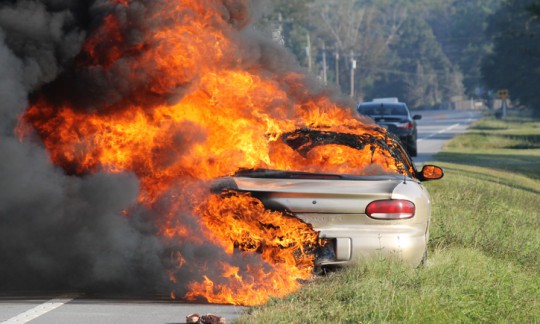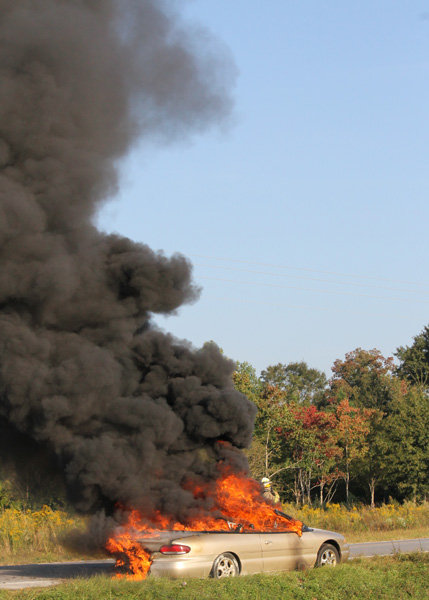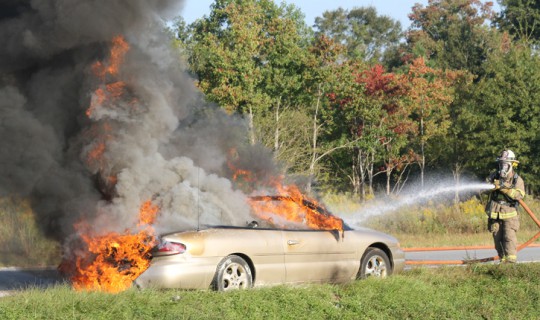Fire Destroys Vehicle On Highway 97
October 13, 2012
There were no injuries in a vehicle fire on Highway 97 south of Highway 4 Saturday morning in Walnut Hill. The Chrysler Sebring was a total loss.
The vehicle was full involved when the Walnut Hill Station of Escambia Fire Rescue arrived on scene.
NorthEscambia.com photos, click to enlarge.
Comments
14 Responses to “Fire Destroys Vehicle On Highway 97”






He was being sarcastic, Ray. It was his way of telling me even CNG cars could catch fire because they DO use motor oil.
Regarding the comment of October 13th regarding “. . . Natural gas powered vehicles don’t use motor oil. . . “. This is not correct. Natural gas vehicle engines have moving internal parts that MUST be lubricated. All major lubricant manufacturers have oils specifically formulated for natural gas engines. Do a Google search for “Natural gas engine oils” and scores of products will be found. As a specific example, Petro-Canada offers their natural gas engine oil under the Sentron (R) trademark.
By the way, a sand blaster was using the air without sand to blow the sand off of himself when a small piece of wire inside the line broke off. Even though he was using less than sixty psi for sand blasting, this was enough to accelerate the wire enough to penetrate his heart and kill him.
So, yes, compressed gas released toward a person can kill him.
we need to set one off to test it
“Does the gas in the tank explode? No, it has to be mixed with oxygen to burn. It has to be confined to explode. Until it ruptures, there is no oxygen. After it ruptures, it is not confined. Ergo, no boom boom.”
A full CNG tank is roughly 2900-3600 PSI. Say the safety release valve fails, then you have to add in the factor of heat increasing the pressure. If you call the instantaneous release of 3600+ PSI a “no boom boom” then your absolutely right….
http://tinyurl.com/9yc6waf
While the vehicle in this article wasn’t on fire it still clearly points out that a ruptured tank WILL KILL YOU!
REGARDING:
“As the article stated, safety relief valves can and do fail.”
Which leads to the follow-up question: What happens if the pressure relief valve fails?
If the pressure doesn’t go up, nothing happens unless it fails by releasing early, in which case the fuel is gone.
If there is a fire which raises the pressure and it goes above the strength of the tank, the tank ruptures.
Does the gas in the tank explode? No, it has to be mixed with oxygen to burn. It has to be confined to explode. Until it ruptures, there is no oxygen. After it ruptures, it is not confined. Ergo, no boom boom.
If the tank ruptures, how much mechanical energy will be released? Roughly the product of pressure times volume released. Will it hit the people in the car? Probably not, the rupture is more likely to be where the fire impinges on it and that is most likely to be away from the body of the vehicle.
In fact, where is the fire most likely to be? Around the engine.
Is the fuel tank near the engine? Nope, not likely.
I’ve had oil fires on my engine. Well, okay AN oil fire on one engine. It didn’t ignite the gasoline and the car was not destroyed. I drove it several more years.
We are still left with the thought that fire is only supported by inflammable material. Gasoline would remain in the areas for a while; natural gas would not remain in the area very long. This shouldn’t be hard to see or accept.
David for keeping fuel from fire
Mike you are right about a small fire extinguisher, I have a small 3lb ABC mounted on the driveshaft hump, kitchen too.
The worse experience I ever had was a rare explosive backfire, which/that ignited a tiny fuel leak. I could see the fire through the hood cowling and reacted by switching off the electrict fuel pump and increasing throttle to full, in order to consume all the gas in the fuel bowls and to also help blow out the fire. Fire shields for fiberglass hoods (bonnets) are cheap insurance.
Inspect your engine compartment for wires and fuel lines that may be rubbing against other components. This condition can lead to an/a electrical short or leak and possibly fire.
“liquid fuels will fall to the ground just as the pictures seem to show burning fuel under the back of the vehicle.”
I believe you’re still missing my original point. The majority of the fire is in the interior and engine compartment. Unless he was carrying several gallons of gas under his hood and in the interior then gasoline had nothing to do with this fire. It was clearly a mechanical issue that, as I previously stated, would have happened with a CNG vehicle as well. At most you would end up with a SLIGHTLY less burned total loss, with the possibility of explosion. As the article stated, safety relief valves can and do fail.
The only difference is the fuel.”
Agreed. For example liquid fuels will fall to the ground just as the pictures seem to show burning fuel under the back of the vehicle. In contrast, a compressed lighter than air gas will shoot out, disperse and rise — not stay near the vehicle, not be around to burn.
This disagrees with the conclusion given in the abstract of the article you cite. They could be right and I could be completely wrong. I can’t read the entire report to judge it. They may identify modes I haven’t considered. They mention they don’t have enough CNG fatalities to check their engineering assumptions and guesses. Assuming they are good engineers, their assumptions err on the side of caution — possibly deciding the unknown but safer system is more dangerous than the known but more dangerous system.
Also note we’re talking diesel buses, not gasoline cars, but I’m not backing down on CNG yet.
David the stubborn
“But if you want to set your motor oil on fire, I guess you CAN do that.”
You don’t SET your oil on fire. The only difference between this car and a CNG vehicle is the fuel. The same exact thing could have happened whether it was CNG or gasoline powered. You act as if its some magical thing that’s completely safe. While I can’t guarantee it, I’m pretty sure the gasoline in this persons vehicle didn’t just spontaneously combust and a mechanical problem caused the fire. My point, whatever happened to this vehicle would have happened whether it was gasoline powered or CNG powered.
BTW, like any mechanical device, these “pressure relief valves” you speak of can fail. Wanna guess what happens when they do? Accidents happen….
http://www.ncbi.nlm.nih.gov/pubmed/15876211 <—-The last 4 sentences is what you're going to want to read.
REGARDING:
“And even if it did you would never have to worry about a tank full of explosive gas under extreme pressure…..”
Oh ye of little faith.
The gas is not explosive, it is combustible. It will only burn at certain concentrations (although it could explode if enclosed in a pressure vessel under those concentrations, I admit). In the case of a rupture, the compressed gas decompresses and gets out of Dodge (or maybe Ford), leaving no fuel behind.
The Texas Railroad Commission showed a number of attempts to create problems, put the tanks in bonfires and set fire. When the temperature got the pressure high enough, the pressure relief valves dumped the gas through the fire without catching fire. They also shot the tanks with armor piercing bullets with the same result — the gas simply blew away without catching fire.
Further, since natural gas is lighter than air, it rises and does not stick around on the ground — unlike LP gas, gasoline, diesel or ethanol.
Good stuff.
But if you want to set your motor oil on fire, I guess you CAN do that.
David for safer vehicles
and clean living
“NOTE
Compressed natural gas vehicles don’t have this problem, a point in their favor.”
Yes, you’re right. Natural gas powered vehicles don’t use motor oil so you would never have to worry about say, slinging a rod and blowing motor oil all over the manifolds. That could never happen and catch a vehicle on fire. And even if it did you would never have to worry about a tank full of explosive gas under extreme pressure…..
NOTE
Compressed natural gas vehicles don’t have this problem, a point in their favor.
Awesome pics, my compliments to the photographer. A small fire extinguisher might’ve saved this vehicle, if one had been handy. Never keep driving if your car is overheating. Glad no people were injured. Curious as to how it started.